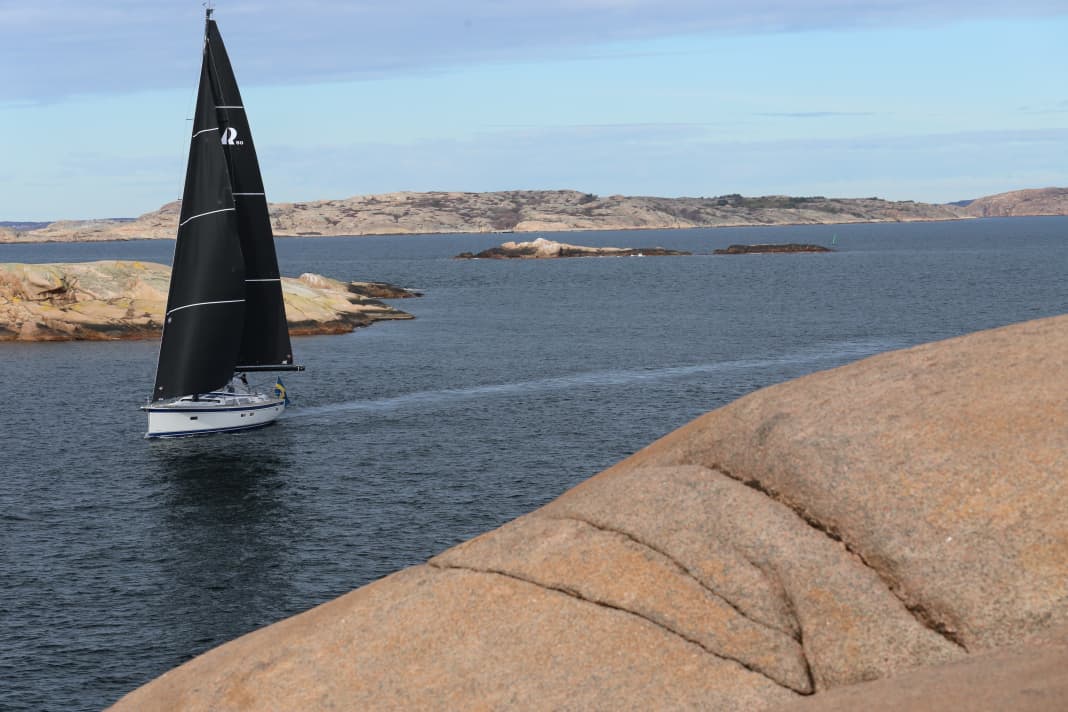





It is not easy to say how it started, when exactly Magnus Rassy began to think more radically, more modernly, more courageously. Some people think he hadn't even really started yet. But when you see and sail the HR 50, you know that's not true. Sure, there are still the blue trim strips, the fixed disc in front of the cockpit, the laminated rubbing strake, the deep GRP stub on which the lead keel hangs, and the overall familiar appearance. Just Hallberg-Rassy.
But there are also twin rudders under the hull, which for a long time would have been unthinkable for a traditional shipyard that once built long keelers. The backstay, main and jib halyards, outhauls and kickers are no longer tensioned by buoys, ropes and winches, but by hydraulic pumps. To supply and control the on-board electrical system, three kilometres of copper cable run through the entire ship like a nervous system, some more than the thickness of a thumb.
The modern rig as a taboo breaker at Hallberg-Rassy?
And then there is this rig from Seldén made of carbon fibre with multiple clear coats, and the membrane sails from Elvstrøm made of high-strength Technora fibres - both as black as a moonless night and, as extras, together as expensive as a 40-foot yacht from a large series. At first glance, the imposing wardrobe, larger than the surface area of a volleyball court, looks like a foreign object, like wide tyres on sports rims on an SUV that is actually designed for comfort. Or, to put it another way, as if Boris Herrmann were to equip his Imoca racer with a teak deck and sofa corner.
You might find that irritating. And indeed, high-tech rigging and cloths have alienated many traditional Hallberg-Rassy owners, who still sail the sea with brass lamps below deck instead of chrome-plated LED spotlights and curtains behind the aluminium-framed cabin windows. Even the competition in the luxury class looked on in amazement at the novelty from Ellös with its polarising set of sails, as if the family-run boat builder was breaking a taboo.
On a Swan or X-Yacht of similar dimensions, such an ornament would not come as a great surprise. But on this epitome of a - let's just say - cosy cruising yacht from a traditional manufactory, where even the veneers for the woodwork are still cut or peeled from a single log and then hand-picked?
The Hallberg-Rassy 50 is a radical giant
It is important to realise that Magnus Rassy is a shipyard boss with the down-to-earth attitude of a block of granite, a man of principle, with attitude. At the same time, however, he is a soulful sailor and a tireless tinkerer who observes the market like no other, analyses innovations for their practicality and studies his competitors. And so he, the bear, the preserver, also possesses an undreamt-of agility.
It was he who coined the term "push-button sailing" more than a decade ago and consistently adapted the concept borrowed from the superyacht segment to his models. Together with Sören Hansen from Elvstrøm, he further developed the furling main and was the first to adopt the FatFurl system with a flared top and over-rounded leech - an option that allows the HR 50 to set a whopping 20 per cent more sail area than a standard main with the same mast height. Over time, many technical refinements were added to create what is now an astonishingly contemporary whole. And in some respects, which are not immediately obvious even to the trained eye, this can certainly be described as radical.
It all starts with the dimensions. Irrespective of her harmonious proportions and the always inspiring hull lines given to her by Germán Frers, that old master among designers, the new Hallberg-Rassy is a giant. She measures a full five metres in width, and this stretches from the centre of the coachroof to the stern almost undiminished. None of her directly comparable competitors are so expansive. With an aspect ratio of 3.05, the cruising yacht from Sweden clearly raises the bar in its already impressive class. There are many good reasons for this - and a whole bundle of stylistic refinements to conceal the undeniable corpulence. But more on that later.
Lots of space and lots of stability
First of all, the Hallberg-Rassy 50 generally gains volume below deck, which many owners can hardly ever have enough of. More importantly, however, it seems that this is the only way to achieve the double helm position fully integrated into the cockpit - while at the same time maintaining wide running decks that can be walked on unhindered thanks to the inboard lower shrouds.
The greater dimensional stability of the wide bulkhead, which has a softly rounded bend aft, is a bonus on top. And another area benefits: the passageway of the longitudinal galley arranged on both sides on the port side. Magnus Rassy went one step further to make this, as well as the storage spaces and work surfaces, as large as possible: for the first time, he chose a Yanmar for the drive instead of the Volvo Penta, which is otherwise obligatory for a Swedish brand, because the Japanese four-cylinder engine with 110 hp is six decisive centimetres narrower. Perhaps this best illustrates the determination with which the shipyard boss himself goes about his work behind the scenes.
Optical tricks conceal the size of the Hallberg-Rassy 50
Of course, the stateliness of this yacht cannot be overlooked, especially not when older model generations next door allow a direct comparison. The HR 48, for example, the highly successful predecessor of the 50, looks like a much smaller sister in comparison: 10 per cent narrower, 1.55 metres shorter in the waterline - a different world.
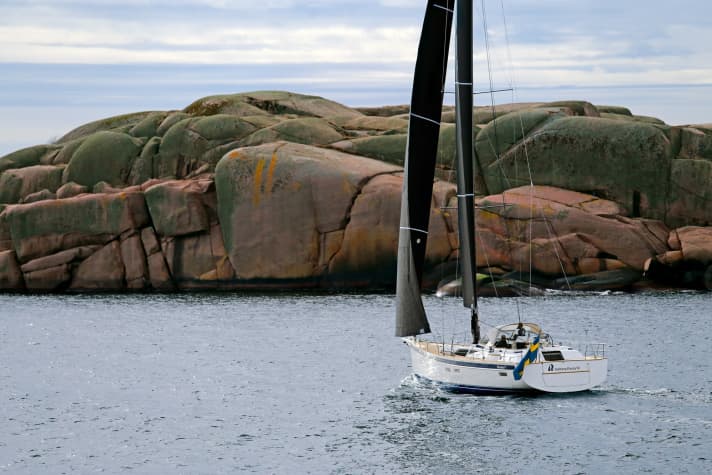
Nevertheless, Germán Frers has managed to hide the sheer opulence of the HR 50 well. To achieve this, he has used small tricks such as extending the coaming of the cockpit aft, which stretches the superstructure. For the same reasons, the bathing platform does not extend over the full height of the transom; thanks to a recessed step, the entire stern appears visually less bulky.
The lowering of the cabin roof in front of the mast is aimed in the same direction. This restricts the headroom in the foredeck somewhat, but almost gives the impression of a river deck from the outside, even though on the Rassy a flat, non-teak-covered GRP plinth extends to the foredeck hatches.
The Hallberg-Rassy 50 shows remarkable manoeuvrability when sailing
The HR 50 also conveys the feeling of elegance and esprit under sail, whereby in the test in 3 to 4 Beaufort and later decreasing breeze she undoubtedly benefited greatly from the costly upgrade of her rig and sail plan. The black Epex membrane set brings 157 square metres to the wind instead of the standard 131 square metres; as a result, the sail carrying capacity has increased to more than 4.5 and is therefore already in the performance cruiser segment.
You can feel it. Despite its displacement of a good 22 tonnes due to the lavish equipment and more than half-full tanks, the test yacht picks up noticeably in light gusts. It converts pressure into speed rather than position, which is partly due to the perfectly profiled cloths and partly to its pronounced rigidity.
In winds of around 10 knots, the HR 50 effortlessly logs 7 knots on the cross and almost 8 knots on half-wind courses. These are excellent figures for a boat of this orientation. Even if the diesel remains almost inaudible in the cockpit, nobody will be tempted to use it in such conditions unless they are heading to leeward.
Unfortunately, we did not have access to optional additional sails for deeper courses. Code Zero (144 square metres) or Gennaker (158 to 249 square metres) are definitely recommended as light wind boosters - also because they can be set comfortably from the large sail load in the foredeck and stowed away there again without any effort. No packing necessary, no dragging aft either. Great!
One shortcoming of the Hallberg-Rassy 50: little storage space on deck
The boat impressed at sea with a pleasantly smooth, yet direct feel for the rudder and good manoeuvrability in the harbour. The overview at the two wheels is also excellent, and it is possible to see the trim lines of the genoa without having to contort yourself. The fully enclosed cockpit provides a high level of safety without restricting the passage on deck too much. At 49 centimetres, pleasantly deep thwarts and high coamings make staying in the cockpit very comfortable. The sprayhood, which extends almost 1.20 metres over the benches when unfolded, also contributes to this; it offers weather protection for up to four crew members.
Only two points gave cause for criticism: the genoa rails running outside the lower shroud jib were too short on construction number 1 and the sheet angle was too open, which is why the boat could not run at the optimum height upwind during the test. This defect has already been rectified on the subsequent boats. "We have lengthened the rails by 50 centimetres," says Magnus Rassy. "In the aft area, they now run closer to the cabin roof."
Another shortcoming is not easy to solve: the limited storage space on deck in relation to the size of the boat. If you add the sail load at the front to the forecastle boxes, the HR 50 offers a total volume of 3.5 cubic metres for bulky equipment. You can get by with this on long journeys, but you have to pack very efficiently if you want to take your bikes, barbecue, SUP, kite or diving tanks with you. Extendable davits for a dinghy that is fit for purpose are therefore definitely recommended.
Like a "holiday home on the Mediterranean"
If Magnus Rassy is right in his assessment that "a holiday home on the Mediterranean is the toughest competition" for this boat, then the fittings below deck are probably just as important, if not more so, than the sailing characteristics. And the HR 50 has plenty to offer here too, not least in terms of volume, light and other amenities.
The furnishings, as it should be with rooms of this size, have become noticeably more modern, more pleasing, but still so ship-like and dignified that you feel cosy in bad weather. At most, it is a little cramped at the aft sloping saloon table when the crew is dining there in full. There is plenty of space everywhere else, including in the navigation corner, where the bench seats two and the table can also be used as a mobile office.
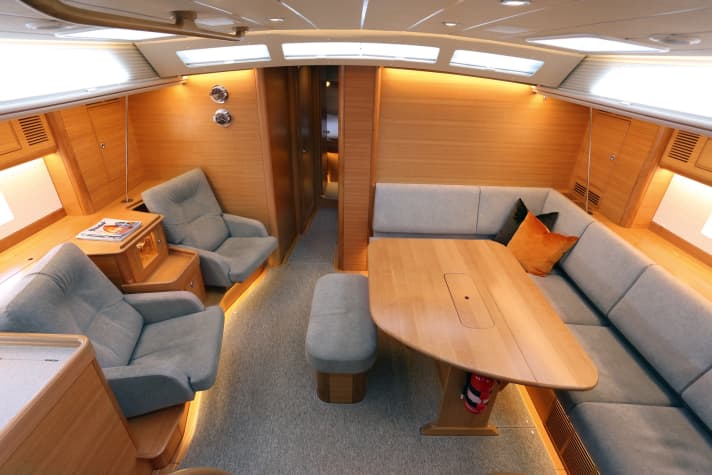
As in other areas, the design is even more impressive at second and third glance than when you first get on board. The seat cushions, for example, which are elaborately moulded from three layers of different hardness, will only be appreciated after a long chat. The powerful water jet from the almost inaudibly quiet fresh water pump, which is soundproofed in the engine room, will only be appreciated when showering and the capacity of the two optional LiFePo battery banks only if you spend a long time on board away from shore power. Despite the electric induction cooker, they offer several days of unrestricted self-sufficiency and can even operate the desalination system without the standard generator having to step in. With its support and the watermaker, owners are not dependent on any external supply for months, provided they have enough provisions and diesel. A cool idea, especially as the size of the tanks and the range of easy-to-use storage compartments below deck make this possible.
Perfectly insulated for year-round use
Even high latitudes need not be avoided with the Hallberg-Rassy. This is guaranteed by the location of the shipyard and the boss's penchant for sailing his boat all year round. This winter, the HR 50 remained in the water without interruption and was even logging miles at Christmas time.
The YACHT test at the beginning of March 2021 showed just how well this works: the temperature dropped to minus ten degrees at night, so that the harbour basin was covered in a thin layer of ice in the morning. Not really the weather for living on board a production boat. Nevertheless, two Webasto heaters took the edge off the cold. In a double pack, they supplied every corner with warm air and created a cosy atmosphere throughout the boat. No condensation on the hull and deck surfaces, which are laminated with a foam core and therefore well insulated, no trickles on the edges of the windscreen, not even steamed-up windows.
An impressive experience: almost the comfort of a house by the sea, unfortunately also at about the same price, but combined with the priceless freedom of being able to put your leisure home anywhere you like - and have lots of sailing fun along the way.
Measured values Hallberg-Rassy 50
Sailing performance, without drift and current
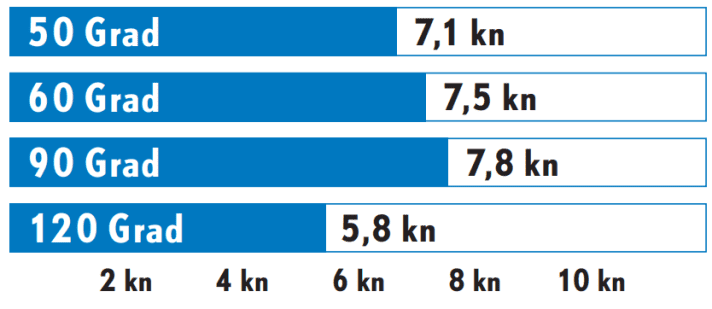
Wind: 10-12 kn (3-4 Bft.), wave height: approx. 0.2 metres
Potential

The standard boat has moderate sails; the HR 50 in the test, on the other hand, has almost 20 per cent more sail area
1: Dimensionless number. Calculation: 2√S/3√V. The higher the value, the more sail area (S) the ship has in relation to the displacement (V).
Berth dimensions
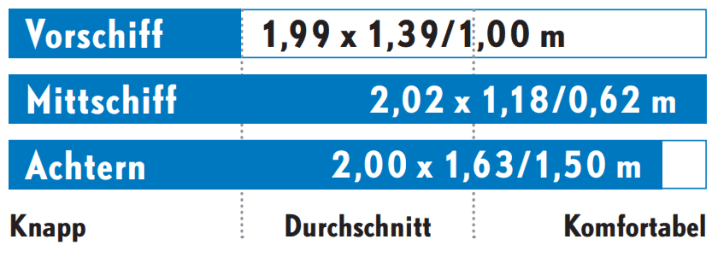
Standing height
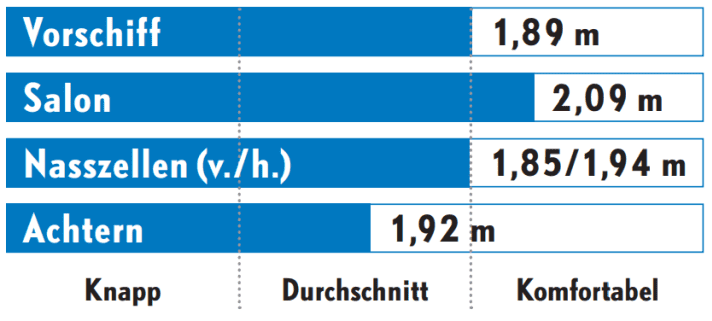
Sound pressure
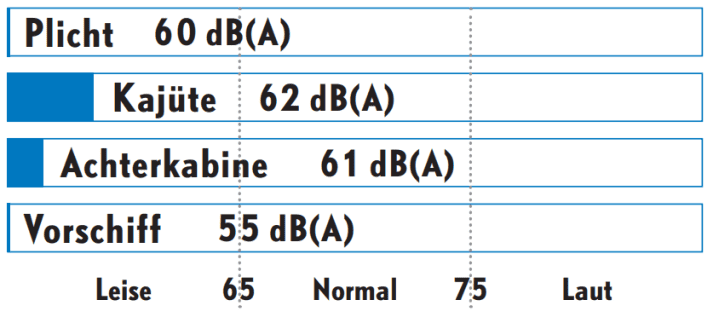
Measured in cruising speed at 70 per cent of maximum speed, corresponding to 7.7 kn at 2300 min -1
YACHT review Hallberg-Rassy 50
More space and finesse with every new model. The Swedes' consistent approach culminated in the Hallberg-Rassy 50 (there is now also an HR57, a 69 is under construction )- and we have hardly anything more to criticise. An expensive tourer, but one that can do practically anything
Design and concept
- + Proven design
- + Well-protected cockpit
- + High degree of self-sufficiency
Sailing performance and trim
- + Very agile with performance sail set
- + Fine rudder feel, good overview
- + Suitable for one hand
Living and finishing quality
- + High-quality woodwork
- + Good ventilation, plenty of natural light
- + Navi space can also be used as an office
Equipment and technology
- + Very good standard equipment
- + Simple operation thanks to E-winches
- - Limited storage space on deck
Technical data Hallberg-Rassy 50

- Design engineer:Germán Frers
- CE design category: A
- Torso length:15,23 m
- Total length: 16,34 m
- Waterline length:14,80 m
- Width: 5,02 m
- Depth:2,35 m
- Theoretical torso speed:9.4 kn
- Weight:21,0 t
- Ballast/proportion:7,15 t/34 %
- Mast height above waterline: 24,90 m
- Mainsail: 63,0 m2
- Furling genoa (105 %):68,5 m2
- machine (Yanmar):81 kW/110 hp
- Fuel tank:1000 l
- Fresh water tank:800 l
- Holding tanks (2): 212 l
Hull and deck construction
GRP sandwich with Divinycell foam core, laminated using the hand lay-up method. Steel girders in the mast area. Laminated bulkheads. Lead keel with deep bilge
Base price (as of May 2023)
- 1,645,000, € ex shipyard, gross incl. 19 % VAT (depending on exchange rate)
Shipyard and distribution
- Shipyard:Hallberg-Rassy, 47431 Ellös, Sweden; www.hallberg-rassy.com
- Distribution:Hallberg-Rassy Deutschland GmbH, An der Wiek 7-15, 23730 Neustadt, info@hallberg-rassy.de, phone 04561/55 86 48
This article appeared in YACHT issue 16/2021 and has been revised for this online version.

